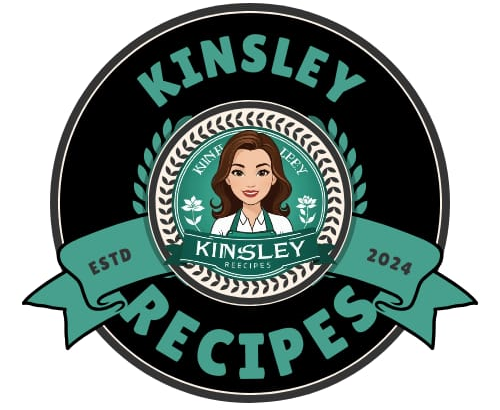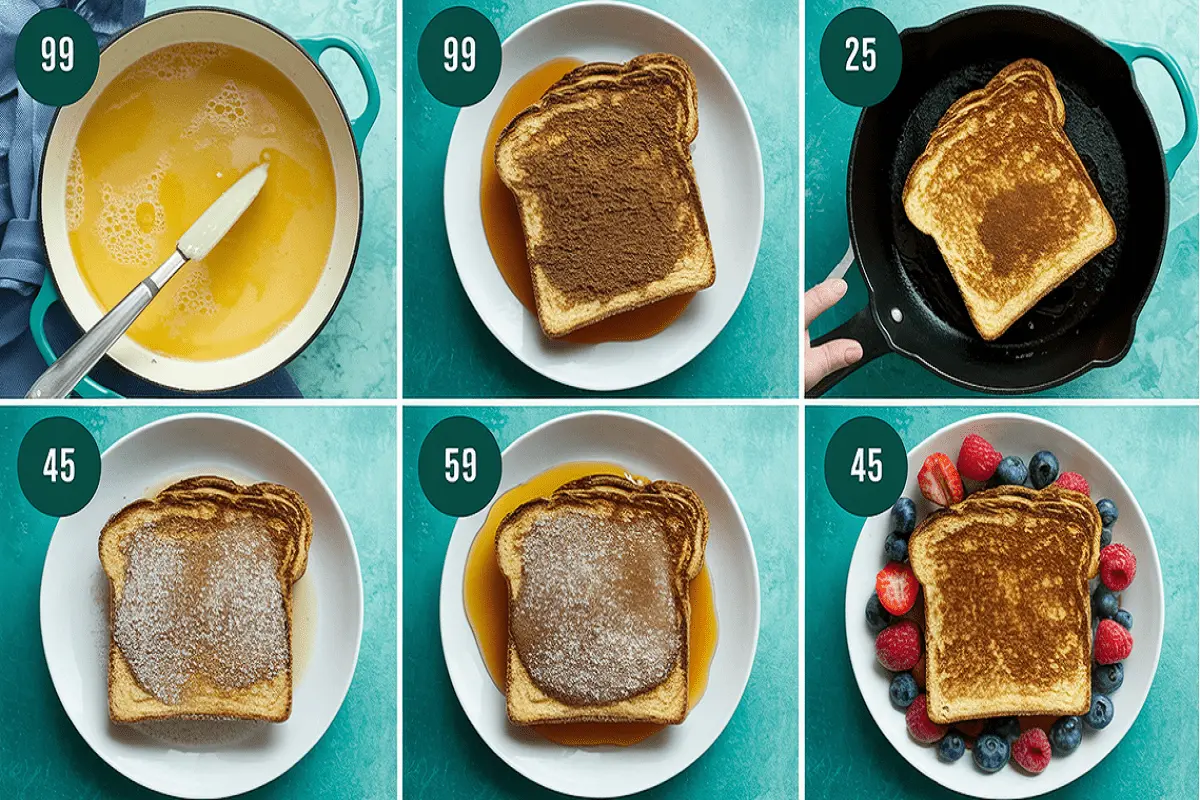French toast is an iconic breakfast dish cherished across the world for its simple preparation and delightful contrast between a soft, custardy interior and a crisp, golden exterior. A key element of perfect French toast is thick bread, which plays a crucial role in determining the dish’s texture and flavor. If you’ve ever wondered why some French toast is perfect while others fall flat, the answer lies largely in choosing the right thick bread. In this guide, we’ll explore the best types of thick bread for French toast and how they help achieve the ideal balance between texture and taste.
This detailed guide will walk you through the ins and outs of selecting the best thick bread for French toast, its various types, how to prepare it, and tips to ensure that your French toast stands out every time. Additionally, we will explore creative variations, answer frequently asked questions, and provide internal and external links to resources that can help you elevate your French toast-making game.
Why Does Bread Type Matter for French Toast?
Choosing the right bread is one of the most critical steps when preparing French toast. The reason is simple: French toast involves soaking bread in a custard-like mixture made of eggs and milk. As a result, the bread must have certain qualities that allow it to absorb the liquid without falling apart.
The Importance of Thickness and Sturdiness
When making French toast, it’s essential to use thick bread that can hold up during soaking. Thin, flimsy slices tend to fall apart, resulting in soggy or broken pieces. Thick slices, on the other hand, have a strong enough structure to absorb the custard mixture without disintegrating. They also ensure that your French toast has a crispy outer layer while maintaining a soft and tender interior.
In addition, slightly stale bread is often preferred over fresh bread. Day-old bread has lost some moisture, which allows it to absorb more custard without becoming overly soggy. This small but important step can drastically improve the texture of your French toast.
What Makes Bread Ideal for French Toast?
Several key characteristics make bread ideal for French toast. Choosing a bread type that meets these criteria will help you avoid the pitfalls of soggy or dry toast and ensure a flavorful and satisfying result:
1. Sturdiness
French toast bread must be able to withstand soaking in the egg mixture. Thin, soft bread will often fall apart when soaked, while thicker, denser bread provides a solid structure that can absorb the liquid without breaking down.
2. Absorption
Good French toast bread should absorb the custard mixture evenly, allowing it to soak into the bread without becoming too wet or soggy. Bread that is slightly stale is better suited for this purpose, as its drier texture absorbs the liquid more effectively.
3. Flavor
The flavor of the bread should complement the custard mixture, not overpower it. Mildly sweet or neutral-flavored breads, such as brioche or challah, work particularly well because they enhance the flavors of the eggs, milk, and any spices you use in the mixture.
By choosing a bread that meets these characteristics, you set yourself up for a more successful and delicious French toast experience.
Types of Thick Bread Commonly Used for French Toast
Not all breads are created equal when it comes to making French toast. Below are some of the best types of thick bread commonly used for this dish, each offering unique characteristics and benefits:
1. Brioche
Brioche is often considered the gold standard for making French toast. This rich, buttery French bread has a tender crumb and high egg and butter content, which allows it to absorb the custard mixture without falling apart. The subtly sweet taste of brioche complements the custard mixture perfectly, rendering it an excellent choice for various sweet French toast recipes.
- Texture: Soft and pillowy, yet sturdy enough for soaking.
- Flavor: Mildly sweet with a buttery aftertaste.
- Best For: Classic sweet French toast, stuffed French toast, or French toast with fruit and syrup.
2. Challah
Challah is a traditional Jewish bread that is also perfect for French toast.Similar to brioche, challah is a bread enriched with eggs, imparting a subtly sweet taste and a soft, yet sturdy texture. Its braided structure makes for a visually stunning French toast and ensures even absorption of the custard.
- Texture: Firm, but soft and tender once soaked.
- Flavor: Mildly sweet and eggy.
- Best For: Both sweet and savory French toast.
3. Sourdough
For those who prefer a tangy flavor in their French toast, sourdough bread is an excellent choice. The dense structure of sourdough allows it to absorb the custard mixture without becoming soggy, and its slightly sour taste pairs well with sweet toppings or fruit-based French toast recipes.
- Texture: Dense and chewy with a firm crust.
- Flavor: Tangy, offering a unique contrast to the sweetness of the custard.
- Best For: Savory French toast or French toast with fruit toppings.
If you’re interested in balancing tangy and sweet flavors, visit our guide on using sourdough in breakfast recipes.
4. French Bread (Baguette)
French bread, particularly baguettes, is another fantastic option for making French toast. When cut into thick slices, the baguette’s crispy crust and chewy interior create a wonderful contrast of textures. French bread is particularly well-suited for rustic French toast dishes or casseroles.
- Texture: Thick crust with a dense, chewy interior.
- Flavor: Mild and neutral, allowing the custard flavors to shine through.
- Best For: French toast casseroles or rustic-style French toast.
5. Thick-Sliced White Bread
Thick-sliced white bread is a budget-friendly option that still works well for French toast. While it may not have the richness of brioche or challah, thick-sliced white bread is readily available and holds up reasonably well when slightly stale.
- Texture: Soft and fluffy, but holds up when sliced thickly.
- Flavor: Neutral, allowing the custard flavors to dominate.
- Best For: Traditional, everyday French toast recipes.
How to Prepare Bread for French Toast
The choice of bread is merely one element of the overall formula. How you prepare it is just as important for creating the perfect French toast. Follow these steps to make sure your bread is ready to shine:
1. Slice Thickly
The first rule of making excellent French toast is to slice your bread thickly—about 1 to 1.5 inches thick. This ensures that the bread soaks up the right amount of custard without becoming too soggy or disintegrating. Thicker slices also help maintain the balance between a crisp exterior and a soft, custard-like interior.
2. Use Slightly Stale Bread
Slightly stale bread works best for French toast because it absorbs the custard mixture more evenly. If you’re working with fresh bread, try leaving it out overnight or lightly toasting it to dry it out before soaking.
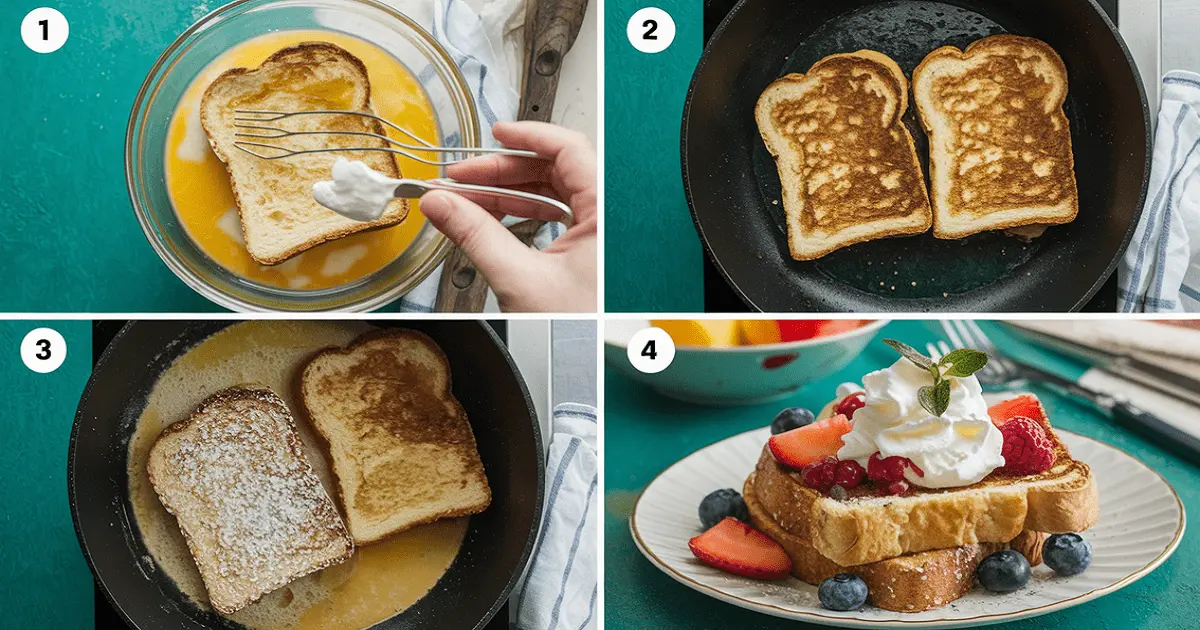
3. Let the Bread Rest After Soaking
After soaking the bread in the custard mixture, allow it to rest for a minute or two on a wire rack. This step ensures that any excess liquid can drain off, preventing your French toast from becoming too soggy when it hits the pan.
For more on preparing your bread, check out our article on cutting and soaking techniques for French toast.
Achieving the Perfect Texture for Thick French Toast
Creating thick, perfect French toast at home requires a few additional tips to ensure you get the best result:
- Soaking Time: The bread should be soaked just long enough to absorb the custard, but not so long that it becomes mushy. For most thick breads, 30-60 seconds per side is sufficient.
- Cook on Medium Heat: Cooking French toast on medium heat allows the exterior to crisp up while the interior remains soft. If the heat is too high, the outside may burn before the custard inside has fully cooked.
- Use a Griddle: Using a griddle or a large non-stick skillet provides an even cooking surface and prevents hot spots, ensuring your French toast cooks evenly.
Creative Variations of Thick French Toast
One of the most exciting aspects of French toast is its incredible versatility. With thick-cut bread as your base, you can create a variety of unique dishes that range from indulgent to savory. Below are several creative variations you can try, each adding its own twist to this classic breakfast favorite:
1. Stuffed French Toast
Thick slices of bread like brioche or challah are perfect for making stuffed French toast. To prepare this decadent variation, slice the bread open to form a pocket or sandwich two slices together. Then, fill the center with sweet fillings such as:
- Cream cheese blended with fresh berries or fruit compote
- Nutella for a rich, chocolatey treat
- Peanut butter or almond butter for a nutty, satisfying flavor
Once stuffed, soak the bread in the custard mixture, ensuring the filling is sealed inside. Cook as usual, and you’ll have a dessert-like French toast that’s perfect for special occasions, holidays, or a weekend brunch. The combination of crispy exterior, creamy filling, and soft custard-soaked bread is a guaranteed hit.
2. French Toast Casserole
When cooking for a group, a French toast casserole offers both convenience and a delicious meal. Instead of frying individual slices, layer thick-cut bread like sourdough or French bread in a baking dish. Pour the custard mixture over the bread, making sure each slice is well-soaked. Allow the dish to rest, either overnight in the refrigerator or for at least an hour, to let the bread absorb the liquid.
Bake the casserole until it’s golden brown and puffed up. This technique is ideal for serving a crowd, as it enables the preparation of a large quantity all at once, eliminating the need to handle each slice individually. You can also customize the casserole by adding ingredients like:
- Fresh berries or sliced bananas
- Chopped nuts or granola for added texture
- Cinnamon, nutmeg, or a drizzle of maple syrup for extra flavor
French toast casserole is a fantastic choice for a make-ahead breakfast that’s sure to delight any crowd.
3. Savory French Toast
While French toast is traditionally associated with sweet flavors, savory French toast offers an exciting and unexpected twist. Instead of adding sugar and spices to the custard mixture, omit the sweeteners and focus on savory ingredients. Some great combinations include:
- Soaking the bread in a mixture of eggs, milk, and herbs like thyme, parsley, or chives
- Serving the French toast with sautéed vegetables like spinach, mushrooms, or bell peppers
- Topping with avocado slices, a fried egg, or a sprinkle of cheese like Parmesan or feta
Using denser breads such as sourdough or whole grain works particularly well for savory French toast because they complement the more robust, savory ingredients. This version is perfect for those who prefer a hearty, filling breakfast that balances textures and flavors.
The Role of Soaking and Cooking in French Toast
While selecting the right bread is crucial for French toast, how you soak and cook the bread is equally important. The method you use for soaking and the temperature you cook the toast at can make a significant difference in the final product. Let’s delve deeper into these crucial aspects:
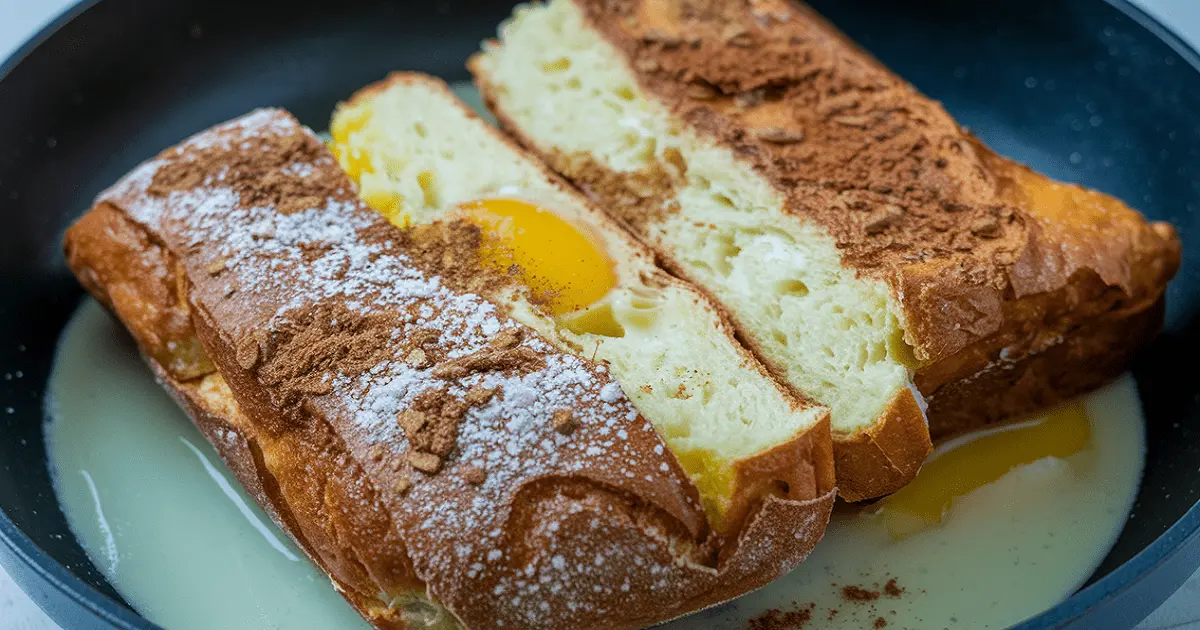
The Importance of Soaking Time
Soaking the bread properly ensures that the custard penetrates the slices evenly. However, soaking too long or too little can impact the texture. Below are some essential guidelines to adhere to:
- For brioche and challah: These enriched breads are softer and can soak up the custard fairly quickly. Soak them for around 30 seconds per side. This will allow them to absorb enough liquid to create a soft interior without falling apart.
- For sourdough and French bread: These breads are denser and can handle a longer soak. Soaking them for 1-2 minutes per side ensures that the custard fully penetrates the bread without turning it soggy.
Always make sure to allow the bread to rest for a minute or two after soaking to ensure the custard is evenly distributed throughout the slices. Letting the bread drain on a wire rack before cooking can prevent excess liquid from making your French toast soggy.
Cooking Temperature and Technique
One common mistake when making French toast is cooking it at too high a temperature. While it might be tempting to crank up the heat to achieve that golden-brown crust quickly, doing so can result in French toast that is burnt on the outside but undercooked on the inside. For optimal results, it is advisable to cook French toast on medium heat.
Here’s a simple technique to ensure your French toast cooks evenly:
- Begin by preheating your griddle or non-stick skillet on medium heat.
- Add a small amount of butter or oil to the pan, just enough to coat the surface. This will help achieve the crispy outer crust without making the toast greasy.
- Cook the soaked bread for about 2-3 minutes per side, or until golden brown. Press lightly with a spatula to ensure the toast is cooked through and evenly crispy on the outside.
For more cooking tips and tricks, visit our article on perfecting the French toast cooking process.
Enhancing Your French Toast with Toppings
The bread you use for French toast is essential, but what you top your French toast with can take the dish to the next level. Here are some popular toppings that pair perfectly with thick French toast:
Sweet Toppings
- Maple Syrup: A classic pairing with French toast, maple syrup adds sweetness and moisture, complementing the custardy interior of the bread.
- Fresh Berries: Strawberries, blueberries, raspberries, or blackberries provide a refreshing burst of flavor and a slight tartness that balances the richness of the French toast.
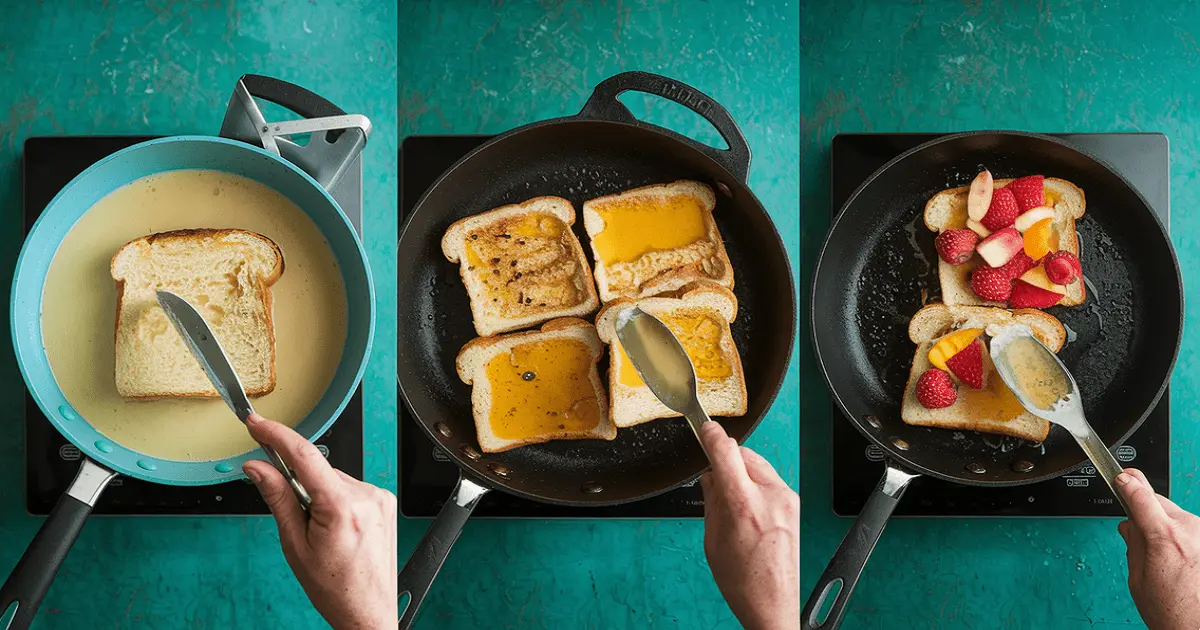
- Whipped Cream: Adding a dollop of freshly whipped cream can enhance the indulgent nature of French toast. For that additional flair, dust a bit of cinnamon or cocoa powder on top.
- Powdered Sugar: A light dusting of powdered sugar is another classic French toast topping. It’s simple but adds just the right amount of sweetness without overpowering the dish.
Savory Toppings
While French toast is often associated with sweet toppings, savory variations are becoming increasingly popular. Here are some savory toppings to consider:
- Avocado: Slices of creamy avocado can provide a satisfying contrast to the slightly sweet custard of the French toast. Finish with a light sprinkle of sea salt and pepper to enhance the flavor..
- Sautéed Vegetables: For a heartier meal, consider topping your French toast with sautéed mushrooms, spinach, or bell peppers. These vegetables provide depth of flavor and pair beautifully with the richness of the bread.
- Fried Egg: A runny fried egg can add a savory element to French toast, especially if you’re using sourdough or whole-grain bread. The yolk creates a rich sauce that enhances the overall dish.
Advanced Techniques for French Toast Lovers
For those looking to take their French toast to the next level, there are several advanced techniques you can use to enhance the texture and flavor. Whether you’re making French toast for a special occasion or simply want to impress your family, these methods will help you create restaurant-quality French toast at home.
Stuffed French Toast
One of the most indulgent ways to enjoy French toast is by making it stuffed. To make stuffed French toast, take two thick slices of brioche or challah, spread your favorite filling between them, and then proceed with the soaking and cooking process. Popular fillings include:
- Cream cheese mixed with fresh fruit
- Nut butters like almond or peanut butter
- Nutella or other chocolate spreads
Stuffed French toast adds a luxurious layer to breakfast, transforming it into a gourmet delight. For more ideas on creating stuffed French toast, visit our stuffed French toast recipe collection.
French Toast Bake or Casserole
For those who are hosting a brunch or feeding a larger crowd, making a French toast bake or casserole is a convenient option. Simply layer slices of thick bread in a baking dish, pour the custard mixture over the top, and allow it to soak overnight. In the morning, bake the casserole until golden and fluffy.
This method is perfect for sourdough or French bread, as their sturdiness can handle the long soaking time. The result is a batch of perfectly cooked French toast without the need to stand over the stove flipping slices individually.
Brûléed French Toast
For an extra-special touch, try brûléeing the top of your French toast. After cooking the French toast as usual, sprinkle a layer of sugar on top and use a kitchen torch to caramelize it. This creates a crackly, caramelized sugar crust that adds a delightful crunch and sweetness to each bite.
This technique works particularly well with brioche or challah, as their sweetness complements the caramelized sugar. If you don’t have a kitchen torch, you can achieve a similar result by broiling the French toast for a few minutes until the sugar melts and hardens.
FAQs About Bread for French Toast
1. What type of bread is used for French toast?
The best types of bread for French toast are those that are sturdy and thick-cut, allowing them to absorb the custard without falling apart. Some of the most popular choices are:
- Brioche: A rich, buttery bread with a tender crumb, perfect for creating soft and custardy French toast.
- Challah: Similar to brioche, challah is an egg-enriched bread that holds up well to soaking and offers a slightly sweet flavor.
- Sourdough bread, with its distinctive tangy taste and firm texture, is an outstanding option for those seeking a more substantial French toast experience.
- French Bread: The thick crust and chewy interior of French bread, such as a baguette, makes it ideal for soaking in the custard mixture and producing a crispy exterior.
2. What is the thick white bread called?
Brioche and Texas toast are two common types of thick white bread often used for French toast. Brioche is known for its rich, slightly sweet flavor, while Texas toast is a thicker-sliced version of white sandwich bread that absorbs custard well, providing a balance between soft interior and crisp edges.
3. How do you keep French toast thick?
To keep French toast thick and prevent it from becoming too soggy, it’s essential to use sturdy, thick-cut bread, such as sourdough, brioche, or challah. The bread should be sliced at least 1 to 1.5 inches thick to absorb enough custard without losing its structure. Soak the bread for just the right amount of time—long enough to absorb the mixture but not so long that it falls apart. Additionally, allowing the bread to rest on a wire rack for a minute before cooking helps to drain any excess liquid, ensuring your French toast stays thick and fluffy.
4. What is thick toast called?
Thick toast is often referred to as Texas toast when made from thick-sliced white bread. Texas toast is commonly used for French toast and other recipes because of its extra thickness, which allows it to hold up to custard soaking and maintain a soft, tender interior while still achieving a crispy exterior when cooked.
Conclusion
Choosing the right thick bread for French toast is the key to creating a delicious and satisfying dish that has the perfect balance of crispy exterior and custard-like interior. Whether you opt for the rich, buttery taste of brioche, the eggy softness of challah, the tangy complexity of sourdough, or the rustic texture of French bread, using thick slices will ensure that your French toast absorbs the custard mixture while holding its structure.
Beyond the bread itself, paying attention to soaking time, cooking temperature, and creative toppings or fillings can elevate your French toast from ordinary to extraordinary. Whether you’re making a simple breakfast for yourself or preparing a stunning brunch for guests, mastering these techniques will help you create the best French toast possible.
For more inspiration, ideas, and tips on how to make the perfect French toast, don’t forget to explore our full range of breakfast recipes and French toast variations.
